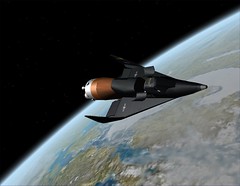
But Dyna-Soar, like its namesakes, was destined for extinction.
In chapter 7 of Burrows’ book, we start in 1958, in which there were five successful US satellite launches, establishing that low Earth orbit could be reached with some predictability. This was also the year that NASA was created to centralize US space efforts. It was built from the existing NACA with the addition of Von Braun’s Huntsville rocket development center and JPL, both transferred under duress (Ike’s orders) from the Army. Some space development efforts remained under military control (such as the first satellite reconnaissance program, later called Corona). But even here, there were turf battles between the Air Force and the CIA over who would control the “spy satellites” that would begin to return useful imagery in August 1960, an amazingly short 30 months after Explorer 1.
The Air Force was also very excited over the prospect of space as a new battlefield, a new “high ground” that must be captured with manned spacecraft before the Soviets could do so. Exactly what this meant was never really clear, even to the Air Force planners who insisted on its necessity. ICBM’s were already assigned to the Air Force, but they meant to also have manned space fighters, recon craft, and bombers, and they would figure out what to do with them later. So they started planning for them.
The development vehicle was a proposed space plane, first called Dyna-Soar, and later the X-20. To be boosted into orbit atop an “expendable” Titan booster, Dyna-Soar would carry a single pilot who would perform various missions in orbit, then re-enter the atmosphere and land like an airplane (a glider actually). The designs and artists’ impressions look cool, but for various reasons, Dyna-Soar never made it to space.
But it did make it to Orbiter! Thanks to a terrific add-on by Erik “Sputnik” Anderson and “Burncycle,” you can fly the Dyna-Soar into its planned polar orbit (this requires a separate add-on, the CVEL Titan), and if you’re good, you can even re-enter and land. As usual for Sputnik, the quality of this add-on is excellent, as is the included PDF manual for it. More pictures at Flickr.
No comments:
Post a Comment